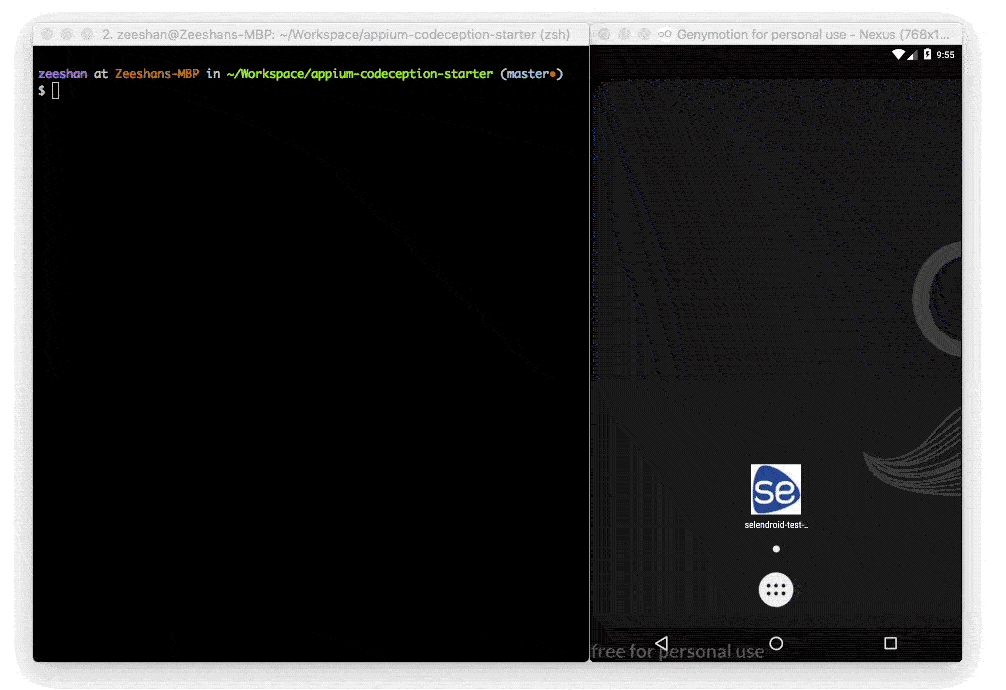Appium Selenium Starter
Simple and easy to use boilerplate for writing tests for mobile or web., (*1)
 ![downloads][downloads-badge]
![MIT License][license-badge]
![Donate][donate-badge], (*2)
![downloads][downloads-badge]
![MIT License][license-badge]
![Donate][donate-badge], (*2)
 ![PRs Welcome][prs-badge]
![Code of Conduct][coc-badge]
![Watch on GitHub][github-watch-badge]
![Star on GitHub][github-star-badge]
[][twitter], (*3)
![PRs Welcome][prs-badge]
![Code of Conduct][coc-badge]
![Watch on GitHub][github-watch-badge]
![Star on GitHub][github-star-badge]
[][twitter], (*3)
Requirements
- PHP >= 7.0
- Appium - For Mobile Testing
- Selenium - For Web application testing
Installation
You can install this appium-selenium-starter using the following methods:, (*4)
Cloning the repo
Run the following command to configure the boilerplate on your machine:, (*5)
git clone git@github.com:me-io/appium-selenium-starter.git
Via composer create-project
Alternatively, you may also install appium-selenium-starter by issuing the Composer create-project command in your
terminal:, (*6)
composer create-project --prefer-dist me-io/appium-selenium-starter
Installing Dependencies
Now run the following command to install required dependencies:, (*7)
composer install
Configuring Environment
There are two cli applications included in starter. To view a list of all commands in these cli applications inside your terminal run the following commands one by one:, (*8)
composer run appium
composer run selenium
Appium
Lets configure your environment for running mobile application testing. Open your terminal and run the following command:, (*9)
composer run appium configure
Selenium
To configure your environment for running selenium server run the below command:, (*10)
composer run selenium configure
Running Example Tests
Note: For running example tests you need to have installed and configured the android emulator or iOS simulator on your machine., (*11)
Before running the mobile tests we need to start the appium server. To start appium server run the following command inside your terminal:, (*12)
composer run appium start
We need to move everything from example directory to the root folder of the project. Run the following command inside your terminal:, (*13)
mv example/* .
You can find the android and ios example tests inside /tests directory. We also put some example apps for android and ios inside /tests/_data/test-apps directory., (*14)
Android Tests
For running android emulator we are using genymotion. Follow this guide
if you do not know how to install and run android emulator. You also need to install the application that you want to test inside android emulator., (*15)
Update Suite
Now you need to update the android.suite.yml you can find this filw inside tests directory. And also update the deviceName to your android emulator device name. If you have genymotion installed you can find the device name from the devices list., (*16)
 , (*17)
, (*17)
Running Tests
To run the android tests run the following codecept command inside your terminal:, (*18)
./vendor/bin/codecept -c example/codeception.yml run android --steps
 , (*19)
, (*19)
Note: Make sure appium server is running before running the android tests., (*20)
iOS Tests
First you need to run the appium server than you need to start the iOS simulator. Use the following if you do not know how to run iOS sumulator http://www.macinstruct.com/node/494., (*21)
Update Suite
Now you need to update the ios.suite.yml you can find this file inside tests directory. Open ios.suite.yml file and update xcodeOrgId and udid to your running simulator identifier string. You can find your identifier string by opening the simulator then Hardware > Device > Manage Devices > Simulators. You will find a list of iOS devices now open the device that you are running and after clicking on the device name you will find the identifier string., (*22)
 , (*23)
, (*23)
Running Tests
To run the ios tests run the following codecept command inside your terminal:, (*24)
./vendor/bin/codecept -c example/codeception.yml run ios --steps
 , (*25)
, (*25)
Contributors
A huge thanks to all of our contributors:, (*26)
| 
Mohamed Meabed
💻 📢 | 
Zeeshan Ahmad
💻 🐛 ⚠️ 📖 |
| :---: | :---: |
, (*27)
License
The code is available under the MIT license., (*28)
 Wallogit.com
Wallogit.com


 ][twitter], (*3)
][twitter], (*3) , (*17)
, (*17) , (*19)
, (*19) , (*23)
, (*23) , (*25)
, (*25)